Alternative energy: Enormous Potential of Tidal Energy
In the conditions of gradual exhaustion and high cost of traditional energy resources, the activation of the development of alternative energy technologies becomes more and more urgent. One of the most promising areas of development in this segment is the construction of power plants that generate energy from the power of the sea tides.
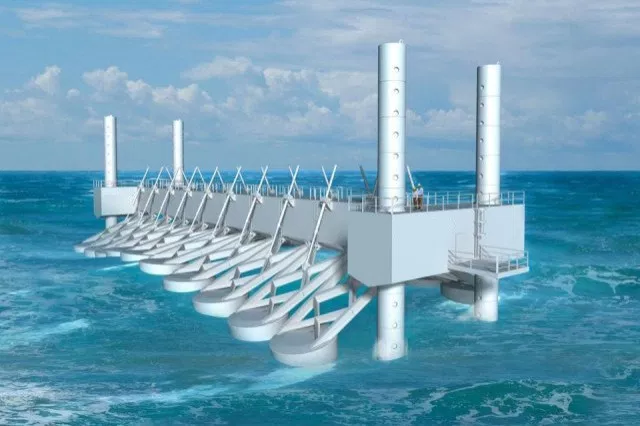
source
How does a tidal power plant work?
The colossal power and scale of the sea tides attracted humanity in ancient times. The first known attempts to use tidal energy were recorded in the tenth century, when people began to build swimming pools with shutters to delay the incoming water.
In the territories of England and France, water mills were built at the dams of the basins, which set millstones, equipment for sawing wood, or acted as pumps in urban water supply systems. The tanks were filled with water and emptied as it decreased at low tide, driving the mill wheels.
Centuries have passed, however, the principle of the useful use of tidal force, taken in service in antiquity, practically has not changed - it has been used in power plants in our time. In the role of "mills" at the stations are hydro units, which serve as generators and pumps.
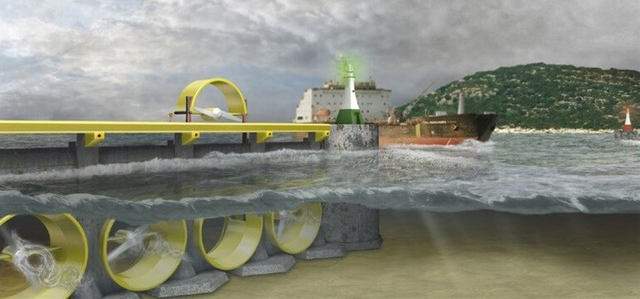
source
Stations that generate energy from tides, using in their work the kinetic energy of terrestrial rotation, are considered one of the types of hydropower facilities, as well as HPP. Tidal power plants (TECs), thus, extract energy from renewable sources, that is, they enter the sphere of alternative energy.
The design of PES may differ depending on the particular project. The classical projects of the stations include the presence of dams and storage pools. Water can be pumped using pumping systems using reversible aggregates. Pumping is carried out to supply water during the absence of a tidal wave in order to ensure the uninterrupted operation of the station. PES equipped with such systems are called pumped storage.
The classical scheme of the basin-type station can work either unilaterally or on a two-sided basis. The first assumes useful work when moving water in only one direction - when filling or emptying the pool. The generation of electricity during the emptying of the reservoir is considered more efficient.
At stations with two-way circuits, turbines operate in both directions of water movement. Electricity production starts at the beginning of the tide, when the sections of the deaf dam overlap. After the water pressure reaches the required force, the turbogenerators are switched on and the pool is filled due to water intake from the marine area.
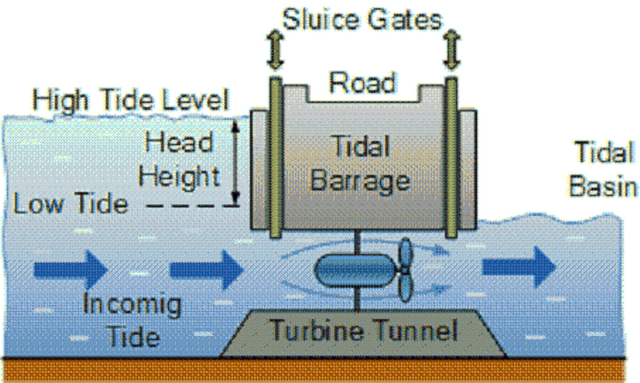
source
After minimizing the difference in water levels in the sea and in the basin, the turbines stop working, the gates open. The levels in the sea and in the basin become the same and the gates are again transferred to the closed position. As the tide lowers, the level difference becomes significant, the water from the basin starts to operate the turbine, after which the pool is gradually emptied. Stations of this type produce energy continuously for 4-5 hours four times a day. Breaks between work periods are no more than 2 hours.
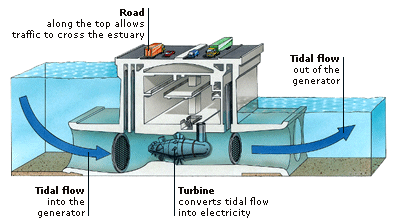
Projects can envisage the installation of not one, but two or three pools in order to increase the time interval of useful work, one cost of implementing such zadumok is quite high. The optimal classical design of the station is the equipping of the facility with one pool when the turbines operate in a two-way mode with pumping water pumping.
Such PES are most in demand in power systems with an excess of output in the failed points of the electricity supply schedule. Reversible units provide pumping of water into the pool during the period of minimum consumption, which allows to increase the generation index at low tide by using additional head and water volume.
Alternative version of PES provides installation of turbines directly on the seabed. Such a scheme does not presuppose the presence of dams and basins. Rotation of turbine blades is carried out directly under the influence of water movement during tides.
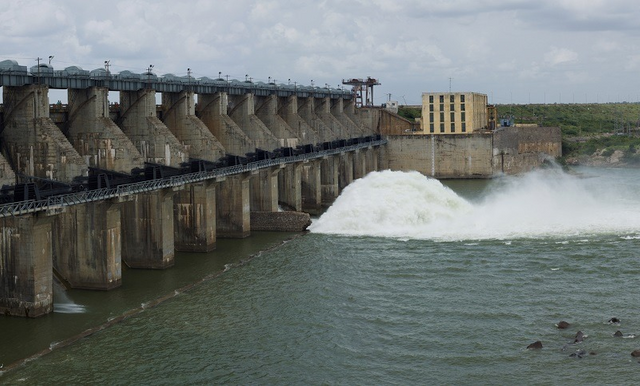
source
The first major station, which operates on this principle, is launched in Ireland. PES SeaGen with a capacity of 1.2 MW is built in the Strangford-Loch Bay area (Irish Sea). The pro-Undra wrote earlier that a similar DeltaStream station was built in Wales. A small station with bottom turbines was launched by the Norwegian operator Hammerfest Strøm. PES provides electricity to two dozen houses located in the city of Hammerfest.
Norwegians do not stop there - the company Statkraft has developed and in the offshore area near the city of Kvalsyundet is already testing the generator, which is an anchor structure of a floating type, which is installed under water. Equipped with four turbines, the design is powered by a tidal force that raises and lowers the generating unit.
Key Benefits of Tidal Energy
What is the attraction of tidal energy? First of all, it is its incomparable advantages over other ways of generating energy. The main factors that favorably allocate tidal power plants from most traditional generating facilities are the actual inexhaustibility of tide and tide sources, as well as the lack of the need for fuel production. PES also have an advantage over hydroelectric power plants, since they do not depend on the water content of the year - tidal and tidal processes are not seasonal and unchanged year-round.
Stability of power generation at PES makes it possible to achieve stable operation of such stations both at current loads and at peak times. Tidal stations guarantee the normal operation of power systems with a constant monthly generation. At the same time, it is necessary to take into account the rather high efficiency of tidal energy facilities, reaching a level of 80%. For comparison, other types of stations that operate on renewable sources show significantly worse results. So, the efficiency of wind generators is 30%, solar panels - up to 35%.
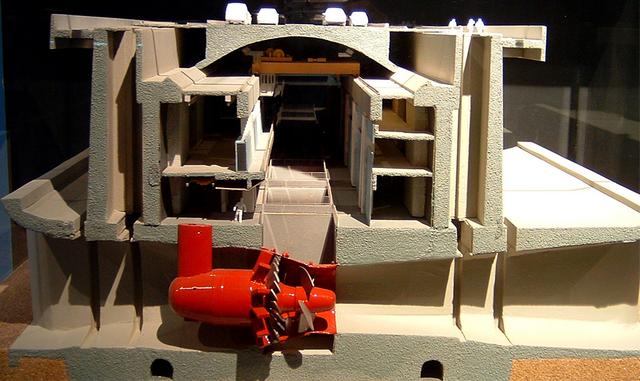
source
Equally important is the financial side of the projects. The experience of using the available PES allows specialists to assert that the cost of the energy generated by such facilities is the lowest in integrated power systems in comparison with the indicators of other types of power plants. From a financial point of view, the launch of PES is no more costly for investors than the implementation of HPP projects at the construction stages.
For example, when designing the Russian Tugur and Mezenskaya stations, it was estimated that, subject to the use of new equipment and effective technological solutions, including floating methods of construction and introduction of orthogonal hydraulic units, the amount of capital expenditures for the construction of PES is equivalent to the amount of expenditures for the construction of hydroelectric power plants.
Nevertheless, the cost of erecting PES is large enough to argue that the launch of new generating facilities may seem unambiguously attractive to investors. In addition, a detrimental factor for potential project participants is the peculiarities of the construction of tidal stations, which cause large financial investments already at the first stages of the work.
Impact on the environment
One of the main advantages of PES is their practically zero impact on the surrounding nature. Tidal power plants, like other generating capacities on renewable energy sources, are environmentally friendly objects. Unlike TPPs, they do not throw combustion products and greenhouse gases into the atmosphere, PES does not lead to thermal air pollution. Generation at facilities operating on tides, unlike nuclear power plants, does not require the utilization of fuel and does not carry the threat of radioactive contamination.
Hydropower facilities, in turn, are inferior to PES by the criterion of operational safety, since in cases of breakdown of dams of hydropower plants, flooding of territories occurs. This risk factor does not exist for tidal stations. In view of the high safety of operation, PES does not pose a threat to the population and the environment due to possible destruction as a result of natural disasters or military actions in the region.
Marine fauna, with the exception of a small part of the plankton, does not suffer from the operation of tidal stations, since the dams of the PES are completely permeable to living organisms that live in the water area. The fish simply passes through the underwater infrastructure of the station unscathed, which was confirmed in the course of monitoring the consequences of the work of the Kislogubskaya PES. Specialists of the Polar Scientific Research Institute of Marine Fisheries and Oceanography named after NM Knipovich did not find any dead or injured fish in the station area.
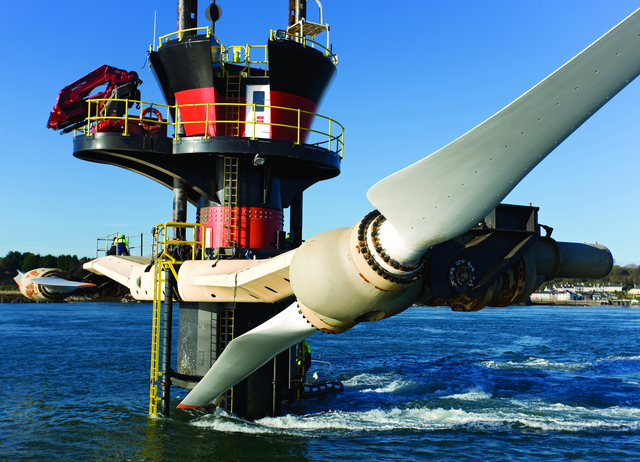
source
Although the operation of PES leads to the death of up to 10% of the plankton that has fallen into the water used by the station, this indicator is much lower than the damage to this group of biological organisms as a result of the operation of the hydropower plant, in which up to 99% of the plankton is destroyed.
There are also alternative opinions - individual experts claim that the marine fauna causes significant harm both at the construction stage and during the operation of tidal stations. It is argued, in particular, that the work of PES leads to a disruption in the exchange of fresh and salt water in the water area and thus worsens the living conditions of marine organisms. Practical tests, however, do not support this assumption - the ecological state of ice and marine fauna, depending, among other things, on the degree of salinity of water, does not change, since the last parameter fluctuates at a maximum of 0.07%, which is an insignificant level.
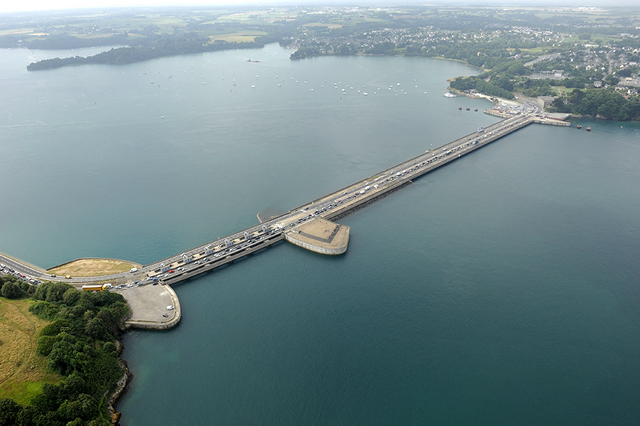
source
The generating potential of tidal energy is unusually high. According to experts, the use of tidal forces will enable the production of 200 to 450 TW of electricity per year. For comparison, in Russia, annual output at small hydropower facilities varies between 200 TW. According to optimistic forecasts, the use of the full potential of tidal phenomena will allow satisfying a quarter of the volume of Russia's electricity needs.
If we talk about the world scale, then, according to experts, the prospects for the development of tidal energy look fantastic - the construction and launch of stations at all points, where possible, will give such an amount of energy that will exceed the needs of mankind by five thousand times and surpass the potential of all remaining reserves of hydrocarbon raw materials of the planet.
Realization of projects of tidal stations both in Russia and all over the world is quite a promising direction in the energy sector. Tidal stations, comparable in cost to construction and indicators of work with conventional HPPs, unlike the latter, are safe in operation and independent of seasonal natural phenomena.
In comparison with other types of stations, they have an even greater number of indisputable advantages and at the same time are characterized by high generation power. Tidal stations are one of the most attractive vectors for the development of the hydropower industry, which not only has the right to life, but it will probably lead to the creation of one of the main energy clusters of the future.

Support @steemstem and the #steemstem
project - curating and supporting quality STEM
related content on Steemit

well-done.
Tidal hydro power for sure is one of those energies we have to use in excess to combat climate change.
@orginalworks
This post has received a 0.61 % upvote from thanks to: @mike11.
thanks to: @mike11.
For more information, click here!!!!
Send minimum 0.100 SBD to bid for votes.
Before sending a transfer to @minnowhelper, verify that your publication meets these conditions (http://www.minnowhelper.com/conditions.php). After the transfer is made, no claims will be received.
The Minnowhelper team is still looking for investors (Minimum 10 SP), if you are interested in this, read the conditions of how to invest click here!!!
ROI Calculator for Investors click here!!!
Congratulations! This post has been awarded a 100% upvote by @lottobot! This post was the winner of lottery #1210, which had a total of 2 entries. @lottobot always has a lottery going on! If you would like to nominate a post for the current lottery, just send 0.1 SBD or STEEM to @lottobot, and include the url of the post you would like to nominate as a memo. Learn more by reading the introductory post! Good luck!
Awesome post that's really informative..... so many innovative ways to generate power....